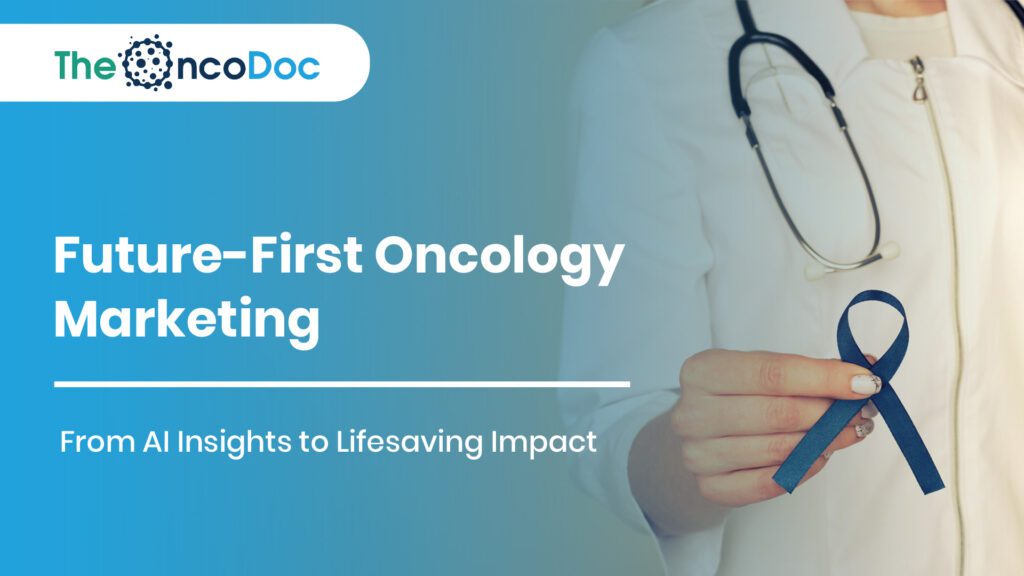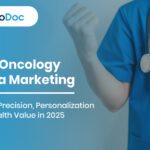Introduction: Shifting the Oncology Marketing Paradigm
The oncology marketing landscape is being reshaped by the fusion of artificial intelligence, patient expectations, and an urgent global need for equitable cancer care. As cancer becomes the second leading cause of death worldwide, oncology marketers are no longer just amplifiers of drug benefits, they are architects of public awareness, behavior change, and early intervention.
In 2025 and beyond, successful oncology pharma marketing will be defined not by product recall or ad reach but by its ability to nudge patient actions, empower doctors, and reduce time-to-diagnosis. This article explores the cutting-edge strategies, tools, and data-driven models that are powering this evolution, with a focus on AI-powered personalization, community-grounded engagement, and outcomes-focused innovation.
1. Intelligent Segmentation: Beyond Demographics
In the past, marketers segmented oncology audiences by age, gender, or geography. Now, AI offers a deeper lens: content affinity, emotional triggers, and behavioral intent.
A 2025 analysis of 2,000 oncologists globally showed that preferences for clinical content varied drastically:
Global, 2025: AI-Powered Oncologist Segmentation by Content Preference
This shift enables micro-campaigns that are as individualized as Netflix recommendations, driving not only engagement but clinical relevance.
2. Precision Public Health Messaging
AI helps localize not just what we say, but where and how we say it. Predictive models mine data from search engines, helplines, and health apps to identify cancer concern spikes in real time. For instance, a sudden surge in searches for “mouth ulcer that won’t heal” in Bihar may indicate rising oral cancer anxiety, prompting local ad rollouts, influencer advocacy, and community diagnostics.
This real-time intelligence has led to a 33% reduction in awareness campaign lead times, enabling agile, geo-targeted action.
3. Community Co-Creation: The Rise of Peer-Led Micro-Influencers
Survivor advocacy is becoming a core marketing asset. In India, Indonesia, and Brazil, pharma firms are nurturing “cancer peer champions”, trained survivors who drive early detection through regional languages and local norms.
Key outcomes:
- 46% higher engagement for survivor-led Reels vs. celebrity-driven ads.
- 31% increase in rural screening participation where peer-led awareness camps were active.
These community voices offer something no brand script can: lived credibility.
4. Symptom-to-Screen Journey Mapping
AI is enabling pharma marketers to map behavioral touchpoints between first symptom and formal diagnosis. A study across Southeast Asia revealed an average 98-day delay between a person noticing a symptom and consulting an oncologist.
Marketers are closing this gap by:
- Delivering WhatsApp-based quizzes on “is it a symptom or side effect?”
- Using Instagram chatbots to recommend nearby diagnostics.
- Integrating e-pharmacy alerts for people buying OTC remedies repeatedly (e.g., antacids for gastric cancer warning signs).
These strategies increase more than simply visibility; they also increase conversion from awareness to action.
5. Emotion-Powered Content Testing
AI emotion engines now analyze the facial reactions, voice tone, and scroll patterns of HCPs and patients during content exposure. This feedback informs emotionally aligned storytelling.
In a test by a pharma brand, two videos were run:
- Version A: Graph-heavy clinical efficacy story.
- Version B: Emotional testimony from a patient who resumed dancing post-immunotherapy.
Result? Version B had 2.8x higher recall and 50% more shares among HCPs.
Empathy isn’t optional, it’s evidence-based marketing.
6. Virtual Tumor Boards & Digital CME
As oncologists demand more peer learning and less pharma push, brands are investing in digital tumor boards and region-specific virtual CMEs.
Preferred Digital Learning Formats Among Oncologists (2025)
These platforms also double as silent brand enablers, embedding drug data within clinician-led dialogues, increasing trust without direct promotion.
7. Vernacular Video Vaults for Patient Literacy
Localized information is becoming a necessity rather than a “good-to-have.” Pharma-sponsored video series are now available on websites like YouTube and ShareChat in areas with low cancer literacy. These series include:
- Animated symptom checkers in Telugu and Bengali
- Explainer videos in Malayalam for chemotherapy side effects
- Voice-based screening tools in Hindi for oral cancer
Result: an 80% increase in video completion rates when content was in native language, as per a 2025 study by India Digital Health Forum.
8. Oncology Chatbots: The New Triage Companion
Chatbots with AI capabilities are becoming essential instruments for early cancer detection and patient involvement. Available on platforms like WhatsApp and patient portals, these 24/7 virtual assistants can:
• Answer frequently asked questions about cancer symptoms and risks
• Guide users to the nearest screening centers or diagnostic camps
• Identify high-risk symptoms and escalate them to tele-oncology teams for urgent intervention
In Maharashtra, one such chatbot embedded in rural telehealth apps successfully triaged over 50,000 symptom entries within six months, significantly easing the workload of frontline healthcare providers. These intelligent bots bridge access gaps, empower patients with immediate support, and play a growing role in improving early cancer diagnosis rates in underserved areas.
9. Gamifying Preventive Behavior
Digital health gamification is making cancer prevention personal, competitive, and fun.
Popular tactics:
- Screening Leaderboards: Districts compete in breast cancer screening goals during awareness months.
- Symptom Quests: Tips for identifying and communicating symptoms in their early stages.
- Badge Systems: Shareable social badges for undergoing tests (e.g., “I Checked My Lungs Today”).
Brands report a 28% increase in screening sign-ups during gamified campaigns vs. static ones.
10. Multilingual IVR and Voice Search for Low-Literacy Regions
To improve cancer awareness in low-literacy populations, oncology brands are embracing voice-based outreach strategies. Key initiatives include:
• Multiple regional languages are offered for toll-free IVR helplines.
• Voice search prompts like “how to check for a breast lump?” integrated with Google Assistant
• Smart speaker-led educational sessions in ASHA and community health centers
These tools ensure vital health information is accessible without the need for reading, making campaigns more inclusive. By removing literacy as a barrier, pharma companies can significantly expand their reach and drive early detection across underserved regions.
Top of Form
Bottom of Form
11. Real-World Evidence as Content Fuel
Healthcare professionals increasingly prefer real-world outcomes over traditional promotional claims. To meet this need, pharma marketers are creating microsites that highlight:
• Long-term survivorship statistics from real patients
• Case reports showcasing successful side-effect management
• Patient-reported quality of life metrics post-treatment
This data-driven storytelling builds clinical credibility and practical relevance. In a 2025 global survey, 34% of oncologists reported greater trust in pharma brands that presented transparent RWE dashboards compared to those offering only product-centric content. By grounding marketing in lived outcomes, brands move from promotion to partnership in the oncology space.
12. Oncology Wearables + Data Integration
Companies that make wearable technology are starting to collaborate with brands to gather information on:
- Unintentional weight loss
- Sleep pattern disruption
- Chronic cough detection
This feeds into apps that provide:
- Symptom alerts
- Tailored awareness content
- Diagnostic clinic links
Such integrations blur the lines between prevention and promotion, adding clinical value while building brand presence.
13. Emotional Loyalty Loops Post-Treatment
Oncology marketing now extends beyond treatment completion, focusing on holistic survivorship support as a strategy for sustained engagement. Post-treatment, patients face emotional, physical, and psychological challenges, prompting pharma brands to offer value-driven support tools that nurture recovery and trust.
These include:
• Guided emotional wellness apps featuring therapy sessions and coping techniques.
• Personalized nutrition plans tailored to specific cancer types and recovery stages.
• Virtual journaling platforms that track mental health, fatigue, and milestones.
By addressing life after treatment, brands build stronger emotional connections, positioning themselves as allies in the survivor’s journey, not just the treatment phase. This continued support fosters loyalty loops, where patients feel seen and supported long-term. Many become community advocates, sharing their experience and the brand’s role in their recovery, organically amplifying the message. Post-treatment care is no longer optional; it’s the new frontier of empathetic, enduring oncology marketing.
14. Micro-Branding for Rural vs. Urban Cohorts
Marketing oncology pharmaceuticals in India requires navigating the substantial differences between rural and urban populations. Urban cohorts prefer high-tech narratives like customized “digital twin” treatment models, whereas rural audiences connect with culturally integrated messaging like folk tunes or community radio. To address this, marketers are adopting micro-branding strategies that tailor content without altering the core molecule.
Examples include:
• Urban campaigns using AR-based visuals to explain clinical trial outcomes.
• Rural campaigns leveraging regional music, street plays, or local dialect storytelling to build awareness.
Each audience segment receives content that feels familiar and trustworthy, yet both remain anchored in the same therapeutic solution. This parallel branding ensures greater emotional engagement, better comprehension, and higher conversion across diverse geographies. By respecting cultural nuance and technological access levels, pharma brands build deeper connections while maintaining scientific consistency in their oncology message.
15. Metrics That Matter in Oncology
Forget impressions. Oncology marketers are tracking real-world behavioral KPIs:
Oncology Marketing Key Performance Indicators (2025)
This outcome-based tracking ensures that marketing actually drives health change, not vanity metrics.
16. Social Listening for Misinformation Management
AI-powered social listening tools actively monitor online platforms, Facebook, YouTube, Reddit, for misleading cancer-related claims such as:
• “Papaya leaf cures leukemia”
• “Chemotherapy is more harmful than cancer”
Once identified, automated alerts trigger brand teams to launch countermeasures using KOL-led videos, survivor testimonials, and evidence-based infographics.
This real-time intervention strategy helps neutralize misinformation before it spreads. In one notable example from Vietnam, such a campaign led to a 55% drop in false cure claims within three weeks. By addressing myths swiftly and credibly, pharma brands reinforce their role as trusted sources in oncology care.
17. Predictive Outreach to GPs Using AI
AI-driven predictive analytics is revolutionizing how pharma engages with General Practitioners (GPs) in oncology care. By analyzing regional health trends, prescription data, and patient demographics, AI can forecast where specific cancer cases, like lung cancer in smokers or breast cancer in women over 40, are likely to emerge.
Pharma marketers can act on these insights by:
• Delivering hyper-relevant CME modules tailored to local disease patterns.
• Equipping GPs with diagnostic aids and referral guides based on regional cancer prevalence.
This proactive, data-informed approach strengthens early detection efforts and helps GPs stay prepared for likely case profiles in their communities. More importantly, it positions pharma brands not as product promoters, but as clinical allies who contribute to better patient outcomes. As predictive tools become more refined, this model of anticipatory engagement is set to redefine how pharma supports frontline care in oncology.
18. AR for Patient Education
Augmented Reality (AR) is transforming how complex oncology concepts are communicated to patients, making them more accessible and engaging. For instance:
• Scanning an educational leaflet with a smartphone reveals an interactive 3D model of tumor growth.
• AR screens in clinic waiting areas display how a drug targets cancer cells in real-time animation.
These immersive experiences simplify medical jargon and bridge the information gap for patients who may feel overwhelmed. Notably, AR-enhanced brochures have demonstrated a 3.5x increase in comprehension compared to traditional 2D visuals, particularly among patients aged 50 and above.
By making invisible biological processes visible and interactive, AR builds trust, enhances recall, and empowers patients to ask informed questions. As healthcare shifts toward patient-centricity, AR stands out as a powerful tool to boost education, reduce fear, and improve adherence across oncology care journeys.
19. Unified Oncology Data Hubs
Pharma firms are now investing in cross-stakeholder oncology platforms that unify:
- Patient-reported outcomes
- Doctor prescription behaviors
- Screening campaign effectiveness
This “digital nervous system” allows for adaptive marketing, where campaign themes auto-adjust based on data feedback loops.
20. Beyond Cancer: Addressing Comorbid Conversations
In many patients, cancer coexists with diabetes, hypertension, or COPD. Leading oncology campaigns are beginning to:
- Address these intersections in content.
- Offer risk calculators that span multiple diseases.
- Train field teams to talk about whole-person health.
This holistic approach positions brands as health allies, not drug pushers.
Conclusion: The Future Is Empathetic + Engineered
The era of generic oncology marketing is over. In 2025, the most effective campaigns combine machine insight with human heart, local nuance with scientific rigor, and digital tools with cultural intelligence.
Pharma companies that win in this space will be those who redefine marketing success, from reach and recall to risk reduction and recovery support. The future isn’t about pushing pills, it’s about changing pathways to ensure more patients are diagnosed early, treated right, and supported long after.
The Oncodoc team is a group of passionate healthcare and marketing professionals dedicated to delivering accurate, engaging, and impactful content. With expertise across medical research, digital strategy, and clinical communication, the team focuses on empowering healthcare professionals and patients alike. Through evidence-based insights and innovative storytelling, Hidoc aims to bridge the gap between medicine and digital engagement, promoting wellness and informed decision-making.



